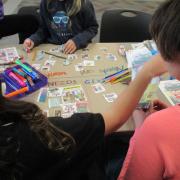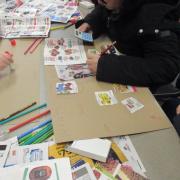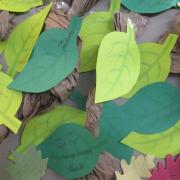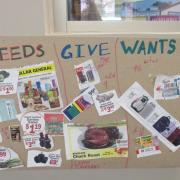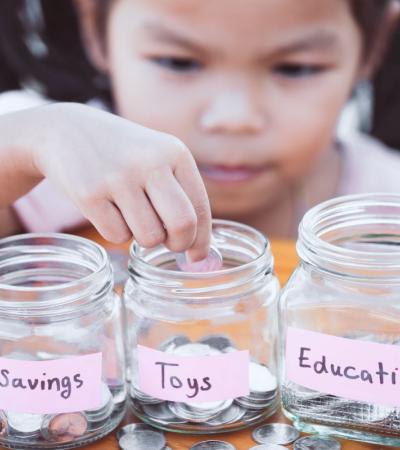In this financial literacy program, kids learn the difference between needs and wants. Using tag boards, magazines and calculators, participants created visual displays of items they would like to have and items they require for daily living, while saving money within their budgets to donate things to others.
Advanced Planning
With a goal of educating youth on managing money and setting goals in an engaging manner, staff submitted the application for the ALA/FINRA Foundation Thinking Money for Kids traveling exhibit in January 2019. Researching ideas and reaching out to potential partners started in December 2018, soon after the announcement of the exhibit application. Staff planned on involving schools by inviting classes to come to the library to experience the display and participate in hands-on activities.
In addition, we wanted to have a big family event plus after-school programs. Iowa State University (ISU) Extension had a curriculum for a series of hands-on activities to learn about earning, saving and spending money that would work nicely for the after-school programs. Needs and Wants was one of the programs in the series.
We have worked with ISU Extension for past programs, so we have a good working relationship with them. Our library was chosen as a host site for the exhibit, but the exhibit was delayed because of COVID-19. After our library was reassigned to a new hosting date, staff reconnected with our partners and refreshed plans. As other hosting libraries shared ideas and their experiences, we included additional activities to our lineup of programs.
Marketing
In promoting the event, the library utilized its website, Facebook page, outdoor digital message board, newsletter (paper and digital copies) and the local newspaper. Our chamber of commerce and the county Extension included postings on their websites and events calendars.
Library staff visited service organizations and schools, emailed follow-up invitations to teachers, and distributed posters around the community. We followed our promotion checklist.
We were disappointed in the number of families that turned out for our grand opening, but we were pleased with the number of kids, and the wide range of ages, that came to our after-school events. We had 100% participation from school classes who visited the library to experience the exhibit.
Budgeting
For the Needs and Wants program, Extension provided supplies, such as glue, scissors, colored pencils, markers and tag board. A bonus was that Extension gave all the kids a calculator that they could use during the activity and then take home. Staff saved sales flyers and magazines for cutting out pictures.
Day-of-event Activity
On the day of the event, library staff set up tables and chairs in the library meeting room and gathered our collected sales flyers and magazines. Extension staff brought their totes of supplies and lesson materials. An Extension youth coordinator led the program with the help of one librarian. The children were very engaged in their projects and stayed focused throughout the program. Parents enjoyed helping as needed.
Program Execution
The Youth Coordinator explained the difference between items that we need for daily living versus items that we want and enjoy, but are not required for daily living. They also emphasized the importance of setting aside some funds for sharing or giving to others.
The students were given a sum of money for a budget and a calculator. Their assignment was to buy the items they needed, buy some items they wanted, and reserve some items to give to others — all without going over their budget. The 12 participants divided their tag boards into sections and started shopping and gluing items onto the appropriate sections.
Upon completion, the kids talked about the reasons they placed particular items in each of the categories. They did an excellent job of choosing well and staying within their budgets. It was quite moving to listen to the reasons why they would give items to others.
After each event, youth were given a leaf to add to the Learning Tree. On the leaf, they were asked to write about one thing they learned during the program. Children would bring their parents back to the library to see the exhibit and show them the leaves on the Learning Tree.
Advice
A beneficial component to all the programs was a "Library Store." After attending an event, participants earned "Library Bucks," which they could use to purchase items from the Library Store. We bought realistic-looking bills and coins for the transactions.
Staff were surprised how many kids did not know how to count out exact change and that kids did not realize that they could receive change back. Therefore, at first, kids were hesitant to part with a $5 bill for a $1 item. It seemed like quite a sacrifice before they understood the concept of making change! This was a huge learning experience in this world of using credit and debit cards.
One family had their children add up their purchases on a piece of paper to see if they had enough money to buy their items instead of having the librarians total the items for them. Kids also learned to save the Library Bucks they earned by attending events so they could buy more expensive items. It was a valuable learning experience.

